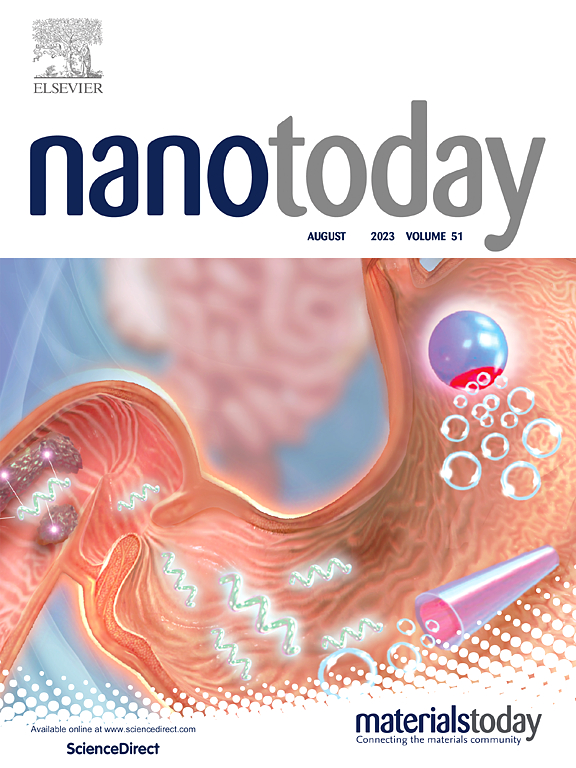由与脂质和聚齐聚糖接枝的β-环糊精衍生的尖锐对比 Janus 星聚合物形成的体内循环纳米长小孔
IF 13.2
1区 材料科学
Q1 CHEMISTRY, MULTIDISCIPLINARY
引用次数: 0
摘要
两亲性嵌段聚合物具有自组装和形成纳米胶束的能力,人们已将其作为纳米载体进行了广泛研究,以改善化疗药物的生物利用度和生物分布,同时降低全身毒性。然而,聚合物胶束往往面临在血液中稳定性差的问题,导致循环时间短和有效载荷泄漏。在此,本研究报告了对一种对比鲜明的 Janus 星聚合物(SJSP)的合理设计,该聚合物由超疏水性脂质分子和超亲水性聚齐聚糖链的多臂组成,并附着在β-环糊精核心上。SJSP 聚合物形成的纳米蜂窝具有稳定的核心和可控的致密隐形外壳,可在血液中有效保护蜂窝,防止有效载荷泄漏和吸附血液蛋白质。研究表明,疏水/亲水平衡可以通过调整脂质和聚齐聚糖臂的数量来优化,从而实现强大的胶束组装。SJSP 胶束系统在体内的血液循环时间明显长于线性系统和其他现有的两亲嵌段共聚物胶束系统。因此,SJSP 胶束设计为开发具有体内转化应用潜力的纳米载体提供了一种前景广阔的策略。本文章由计算机程序翻译,如有差异,请以英文原文为准。
Long in vivo circulating nanomicelles formed by sharp-contrast Janus star polymers derived from β-cyclodextrin grafted with lipids and polyzwitterions
Amphiphilic block polymers have the ability to self-assemble and form nanomicelles, which have been extensively studied as nanocarriers for improving the bioavailability and biodistribution of chemotherapeutic drugs while reducing systemic toxicity. However, polymer micelles often face issues with poor stability in the bloodstream, leading to a short circulation time and leakage of the payload. Here, this work reports a rational design of a sharp-contrast Janus star polymer (SJSP) consisting of multiple arms of superhydrophobic lipid moieties and superhydrophilic polyzwitterion chains attached to a β-cyclodextrin core. The SJSP polymer forms nanomicelles possessing a stable core and a controllable and dense stealth shell that effectively protects them in the bloodstream, preventing payload leakage and blood protein adsorption. It is demonstrated that the hydrophobic/hydrophilic balance can be optimized to achieve strong micellar assembly by adjusting the number of lipid and polyzwitterion arms. The SJSP micelle system shows significantly longer blood circulation time in vivo compared to linear counterparts and other available amphiphilic block copolymer micelle systems. Therefore, the SJSP micelle design offers a promising strategy for developing nanocarriers with potential for translational applications in vivo.
求助全文
通过发布文献求助,成功后即可免费获取论文全文。
去求助
来源期刊

Nano Today
工程技术-材料科学:综合
CiteScore
21.50
自引率
3.40%
发文量
305
审稿时长
40 days
期刊介绍:
Nano Today is a journal dedicated to publishing influential and innovative work in the field of nanoscience and technology. It covers a wide range of subject areas including biomaterials, materials chemistry, materials science, chemistry, bioengineering, biochemistry, genetics and molecular biology, engineering, and nanotechnology. The journal considers articles that inform readers about the latest research, breakthroughs, and topical issues in these fields. It provides comprehensive coverage through a mixture of peer-reviewed articles, research news, and information on key developments. Nano Today is abstracted and indexed in Science Citation Index, Ei Compendex, Embase, Scopus, and INSPEC.
 求助内容:
求助内容: 应助结果提醒方式:
应助结果提醒方式:


